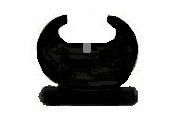As you've been looking around here, I'm sure you know the front sight on a new GPR is intentionally left high so the new gun will shoot low?
The idea is it is easier to file off material than it is to put it on and a tall front sight will make a gun shoot low.
Also, the new GPR was shipped with some incredibly tough bore grease that needs to be cleaned out by using disk brake cleaner, lacquer thinner, acetone or denatured alcohol (less effective).
They also need to be shot at least 100 rounds worth before they stop cutting patches.
That said, IMO, the gap between the horns is used for long range shooting.
The horizontal top of the lower area with the notch is the actual sight used for normal shooting.
As you may notice, the V notch is rather shallow.
That is intended to force you to aligh the top of the front sight blade so it is centered in the notch and the top of it is in line with the top of the horizontal area.
With the sights aligned this way (front blade centered and top in line with the rear sight) the gun is considered aimed.
Use a very large target or a smaller target stapled towards the top of a large piece of cardboard so the low shots will show up.
Some people sight their guns in so the sights are pointed towards the center of the bulls eye.
Some people who are planning on doing only target shooting like to hold the point of aim at the bottom of the black bulls eye.
I prefer to use the "aim at where you want to hit" school of thinking.
Remember, raising the rear sight or filing down the top surface of the front sight will raise the point of impact for the group.
Do your first shooting at 25 yards distance.
IMO, that is a good distance to work at until you have adjusted the sights to bring the group up to the point of aim.
Fire at least 5 shots to determine where the gun is hitting while aiming exactly at the same point on the target. Use the center of the pattern as the correct location.
There are several things that can effect the group size and point of impact.
The powder load, the powder type, the patch thickness and the patch lube.
Changing any of these will change the point of impact so, if your gun is a .50 caliber start off with something like a 65 grain powder load.
I'm sure the others will jump in and give you a lot more information.

























